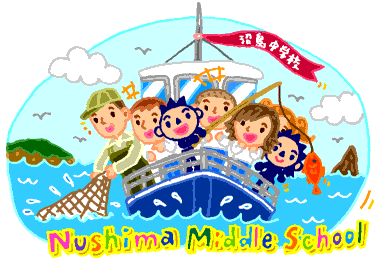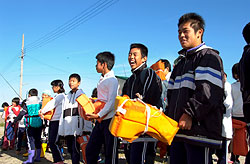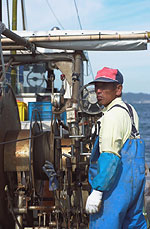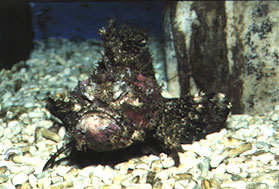Nushima
Middle School
|
|
 |
|
| The school festival, field day, and other big days students look forward to |
|

|
Special Events
Every now and again the school's students take part in a "work experience" outing on the island's fishing fleet. Find out what it's like to work on a trawler and what fish they catch. Learn what happens when a squid spits on you. Imagine the flavors of the dishes prepared by students' parents.
|
 ==> Cooking the Catch ==> Cooking the Catch |
|
Experiencing Fishing
Watching
Dad at Work
When people think of Nushima,
the first thing that usually comes to mind is delicious fish.
The waters around this island have long been famous as fishing
grounds for top-rate fish. Fishing is the most important industry
on the island, and 70% of the parents of the children at Nushima
Middle School work in this field.
|
|
|
|
|
|
A clear sky
on the day of the "fishing experience" outing. Listening
to the skipper: Shipboard rules of behavior and what fish to handle
with care.
|
 |
|
But fishing is done in the early
morning, beginning while it is still dark outside, so the children
rarely have the chance to go out on a boat and help their parents.
In order for the children to see what commercial fishing entails,
though, the whole school sometimes takes special field trips to
fishing grounds, where the students can experience this kind of
work for themselves.
|
| The
salt wind in their faces, putting to sea at last! |
|
|
A field trip was held this year on October
20, the first in two years, with the cooperation of the students' fathers,
who own the vessels. It was a clear fall morning without a cloud in
sight, and the sea was calm--a perfect day for fishing. Five trawlers
were standing by at the wharf. At 8:30 in the morning students began
boarding the boats in groups of four or five. One father instructed
the children, saying, "You must obey our orders and be careful with
stonefish and rays, because they're poisonous to touch." After these
instructions, the boats began to move out to sea one by one. The ships
went out in different directions and stopped at points about 2 kilometers
offshore. Because they were going to use a trawl (a type of net dragged
along the bottom of the sea), the ships came to a place where the water
is about 45 meters (about 150 feet) deep. A net measuring 1.2 meters
high and 24 meters long was dropped into the sea. While watching the
sonar that searches for schools of fish, the students rode along as
the boat dragged the net for about 40 minutes. Then a motor-winch on
the deck reeled in the net. Sea bream, horse mackerel, and barracudas
appeared within the net's fine mesh, one after another.
"A Squid Spit Ink on Me!"
 |
|
The fish caught in the net were
divided up, and a number of them were not suitable for consumption.
The students were somewhat taken aback as dozens of sharp-eyed
seagulls spotted the fish and began to circle the boats furiously.
The children gathered the fish that people will not eat and had
fun feeding them to the seagulls, throwing them into the air.
|
|

Here
you are, seagulls! You can have the small fish people can't eat.
|
| So many
different kinds of fish! |
|
|
|
|
|
Third-year student Chiko Aoishi
says, "When we were going out to sea, the waves were big and the
boat rocked back and forth. We were hit with a lot of ocean spray.
When we reeled in the net, there were barracudas, horse mackerel,
huge jellyfish, and other fish. A whole bunch of seagulls flew
over to our boat. It was a little scary, but it was fun." Second-year
student Erina Adachi says, "The thing that surprised me most was
all the birds that were flying around after we dragged the net."
There were also some students
who became quite seasick and had to spend the whole time lying
down, but when the catch (there were even some ships that hauled
in small sharks and sea horses) was unloaded from the net, they
all gave a cheer. Third-year student Shogo Matsumoto says, "The
coolest part was fighting with a moray eel. It took me three times
to throw it back into the water; the first time, it bit one of
my gloves. That was really interesting!" Second-year student Koji
Hayami says, "A squid spit ink on me and my shirt turned black.
It was fun, though."
|
|
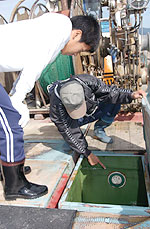 |
| |
|
What's
it like under the deck? Dad explains it all. |
|
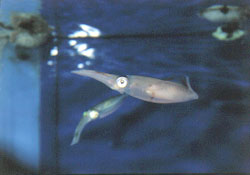
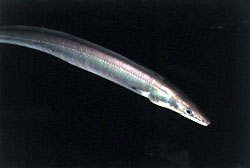
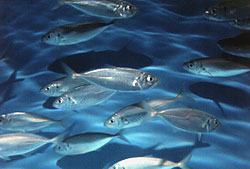
|
|
The students' fathers told the
children about the joys and hardships of working in the fishing
industry: "The boat is often buffeted by waves, and I've fallen
down on the deck more times than I can count. But still the sea
is fascinating."
Two hours after they went to sea,
all of the boats returned to harbor filled with delicious fish,
the pride of Nushima. The combined catch of all five vessels was:
80 to 90 horse mackerel, about 100 barracudas, 15 cuttlefish,
20 sea bream, 2 hamo eels, and 40 to 50 squids. Each student
received a dozen or so fish to take home as souvenirs of the outing
as this year's field trip came to a close.
|
|
(From the top) Aori-ika
cuttlefish, hamo eel, horse mackerel.
(Courtesy of Toba Aquarium)
|
|
|
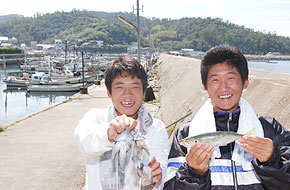 |
|
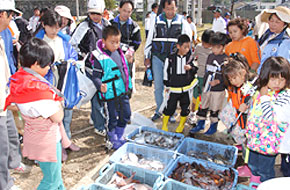 |
| We caught
these! |
|
Delighted
with the big catch! The students' mothers and elementary school
students examine the results of a hard day's fishing. |



Send your comments and questions here.
(nushima@jcic.or.jp)

|

